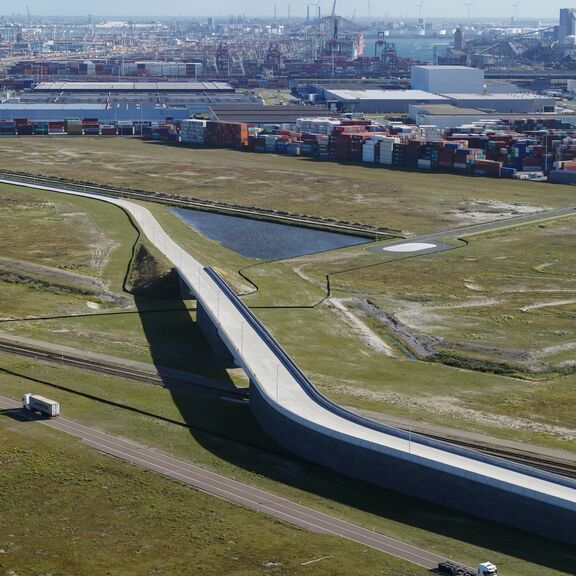The Port of Rotterdam Authority officially commissions Container Exchange Route
Reading time: 3 minutes
After a long preliminary phase, the Container Exchange Route (CER) on the Maasvlakte was officially commissioned on 28 November.
The 17-kilometre-long closed road network currently links the container terminals of Rotterdam World Gateway (RWG), the Delta terminal of Hutchison Ports ECT Rotterdam (ECT), the terminals and depots of QTerminals Kramer Rotterdam (KDD, RCT and DCS) and the State Inspection Terminal for Customs. The connected parties will use the CER through various carriers, permitting different forms of transport, such as Multi Trailer Systems (MTS), Terminal Tractor Units with chassis (TT) and normal trucks.
Boudewijn Siemons, interim CEO and COO of Port of Rotterdam Authority: “I’m delighted that the Container Exchange Route has now been commissioned. The Port of Rotterdam Authority wants to further strengthen the port of Rotterdam's position as container hub, but this is only possible if increasing container volumes can be processed safely, efficiently and sustainably. The interchange of containers via the CER represents a major contribution to this. This cooperation between the affiliated parties is not only unique in the port of Rotterdam itself, but also in global terms.”
Unique in its class
The route comprises some 17 kilometres of paved road, 3 level junctions, 5 rail crossings and various systems, such as lighting, cables and pipelines, traffic lights and access barriers. With the CER, the Port Authority is introducing – together with the affiliated parties and carriers – a unique system that does not exist in any other port at this scale. This cooperation demands that the parties share information and collaborate in the interest of the port of Rotterdam.

Honest transport
The CER road network forms a ‘closed’ transport route and is not publicly accessible. Only transport companies with an Authorised Economic Operator (AEO) permit from Customs may transport containers from one location to another on this route. So the CER is perfectly in line with the desire of the Customs authorities to take further measures in the port of Rotterdam in its war against the drugs trade and subversion.
Transport between terminals and the State Inspection Terminal will basically be routed entirely over the CER, ensuring this transport loop runs in a controlled and closed environment. These containers may only be transported over public roads in exceptional cases. So the CER route not only contributes to greater accessibility, but also to enhancing the security and integrity of the logistics chain.

Further cooperation
Now that the initial parties will be using the CER, volumes will gradually increase. In the near future, new connections with terminals, depots and distribution centres are expected. The Port Authority aims to connect as many container companies as possible with the CER, as long as they have the option of a physical link.
